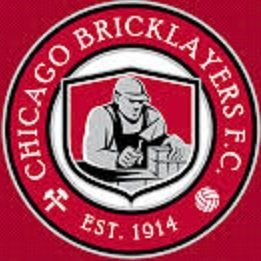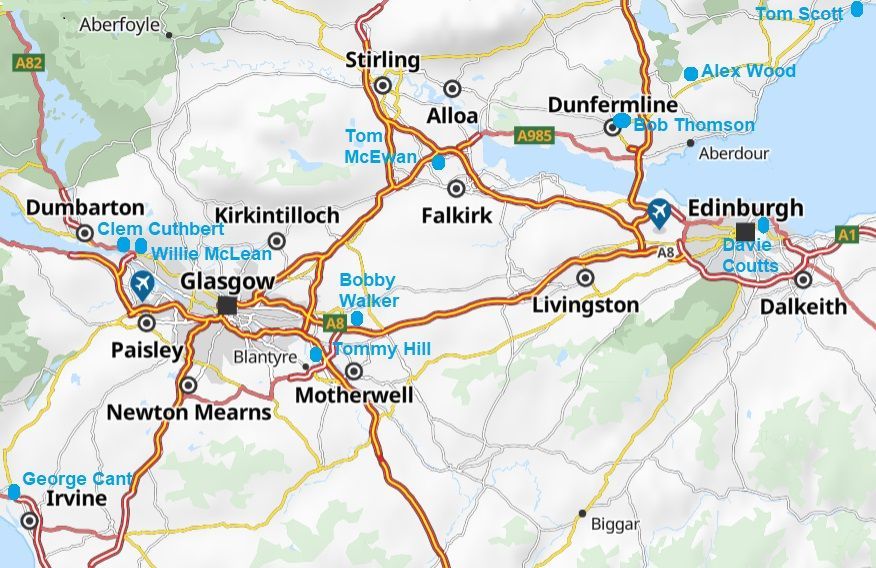The Brickies
-Scots-team Chicago

At the beginning of the 1920s American soccer boasted three major cup competitions, the Lewis Cup, confined to member of the American Soccer League, the American Cup, founded in 1884, organised by the American Football Association and restricted to its then mainly eastern members. And then there was, in 1924 replacing the latter, the National Challenge, also known as the Open Cup, and now the Lamar Hunt Cup, its trophy originally donated in 1914 by the Scotch whisky magnate, Thomas Dewar, it participants drawn then and still from a far wider pool of clubs.
And in 1928 and again in 1931 a Chicago team reached the Open Cup finals, only to lose twice on replay, defeated by the New York Nationals and Fall River F.C. respectively. It was not the first to do so. Chicago Canadian Club, itself an indication of the influence on football from across the U.S.'s northern border, had done it three years earlier, without the need for more than one game, but this newer team, the Bricklayers and Masons F.C., the forerunner of today's Chicago Fire, was doubly intriguing, both for what it said on the tin and what it did not. More than a few of its players did indeed lay bricks and work with stone for a living, hence the nickname, the "Trowel Wielders". But not so obvious was, in 1928 at least, that it was very much a team of Scots. Whilst the New York Nationals had its fair share, four at least playing, twelve in all in the squad, for the Chicago team it was nine of the eleven that day and two remaining almost counting anyway. One was a Geordie and the other a former Canadian.
But the Nationals was a team with strong backing from the New York Giants baseball franchise. It could afford to buy its players. They were, if you like, a Senior club. However, the Bricklayers were not in their league, either literally or financially. Whilst they played on a field that was next to the then Chicago Red Sox stadium, on baseball fixture days in summer it was the car-park. They were a Junior club, in terms of Scotland today, Lowland or Highland League, in the game as much for proven love as, albeit, one shamateur, Scots way or another, undoubted remuneration via gate-money. The spectators are there to be seen.
Founded in 1914, in the years immediately after The Great War the club, indeed Chicago, was reinforced with a renewed inflow of young immigrants. And those from Scotland, drawn from right across the Central Belt, came with not just the soccer contagion already in their blood but considerable, already nurtured and provan talent, which by the middle of the 1920s had at Bricklayers' Park coalesced into a formidable squad.

Of the younger pairing on the right was Tom Scott. He hailed from Leven in Fife and before crossing The Pond at the age of twenty-one in 1923 had been on the books of neighbouring Methil's East Fife, again in the Second Division. And on the left was Alex Wood, also a Fifer, from Lochgelly, the nephew of Johnny "Tokey" Duncan, who had just joined Leicester City, where he would become both the star and a Scottish international. And Alex, arriving in the American Mid-West at fourteen but having learned the game Scotland, would go on to international honours himself. Football would take him first to Detroit and then New York, from where he was in the US team that at the first World Cup in 1930 reached the semi-final. That is before returning in 1933 to Britain, in fact to Leicester, from there he would to the outbreak of WWII pursue a successful, English League career, albeit eventually living out the rest of his days back in the States.

As to the half-back line, where the Geordie, Peter Quinn, with English League experience with Bradford and Coventry, was in the centre, on the left was Bob Thomson. He had been born in Dunfermline in 1901 but had emigrated for a first time with his family in 1903 only to return by 1907. So again he learned his football the Scots way before re-emigrating, seemingly after the death of his mother in 1923. This was whilst on the right was Tommy Hill, two years older, who hailed from Hamilton, was in 1928 almost thirty, worked as a known, actual bricklayer and had arrived in 1920, from where he had until 1925 been part of the Southern Illinois soccer scene before Chicago itself.
And finally to the front-line. At centre-forward was the former Canadian Club man, Joe Phillips, with to his right Davie Coutts, born in Kirknewton in 1899 and raised in Leith. He joined the club on arrival from Edinburgh six years earlier. Then to his left was Clem (Clement) Cuthbert, also a bricklayer to trade and one of two in attack from Clydebank. He had been born in 1903, arrived at nineteen in 1922 by when he is said to have played with both Clyde itself, then in the Scottish First Division and for the Stirling -club, Kings Park, in the Second. The right-winger too came from Clydebank. He was Willie McLean, at 5 ft 3 ins a physical light-weight but one with great talent, who would also go on to play for the US national-team, this time at the 1934 World Cup. He had arrived in the States at nineteen in 1923, joined the again Chicago club, Pullman F.C., then the Canadians and finally The Brickies until 1932, winning honours with each. That was before moving to St. Louis and more footballing success until 1936, when he collapsed on-field, stepped away from the game and from 1938 was thought simply to have disappeared. In fact he had had a mental-breakdown, would return to Chicago in 1937, in 1941 there abandon his family, changing his name and moving to Iowa, where in 1946 he would have a second break-down and for thirteen years until his death in 1959 be institutionalised. The full story was in 2022 brilliantly investigated by Pablo Maurer and Matt Pentz for The Atlantic, see Wee Willie McLean.
This was whilst at outside-left there was Bobby Walker. Born in Coatbridge he is said to have played for his home-town team, Albion Rovers. Moreover, whilst the club is now in the Lowland League, in 1920 it had reached and lost the Scottish Cup Final and was mid-table in the First Division. However, at the end of 1922-23, even with him recorded as having just stepped up to its first-team squad, "The Wee Rovers" were relegated, soccer in the America was beginning to boom, as it would for much of the remainder of the decade, and he clearly, like many others, decided his futures, both in life and football, lay elsewhere. In 1923 he sailed for the New World, where once in Chicago he joined The Brickies almost immediately, in 1929 would marry Scots-born Priscilla Brownlie and in 1962 die still in the city.
